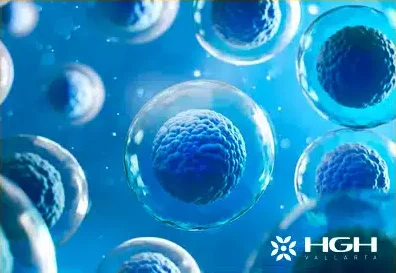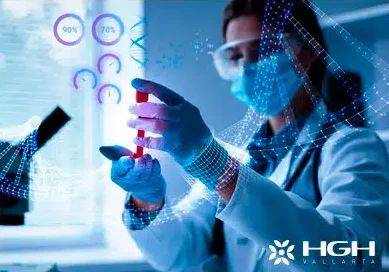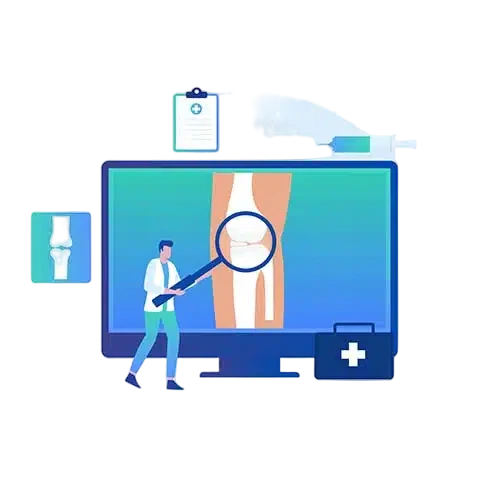
What Are Stem Cells?

Learn All There Is About Stem Cells and Stem Cell Treatment
Stem cells have garnered significant attention in recent years due to their remarkable potential in medicine. Ongoing research continues to expand our understanding of their applications in treating various diseases and injuries.
HGH Vallarta Clinic has created this page to provide valuable information about stem cells, including their function, importance, and potential clinical applications.

Stem Cells 101
Stem cells are undifferentiated cells that can renew themselves and differentiate into various specialized cell types within the human body. Essentially, they serve as the body’s raw materials, giving rise to all other cells. This unique characteristic makes stem cells a promising area of research in regenerative medicine, offering the potential to repair damaged tissues and combat various diseases.

Different Types of Stem Cells
Stem cells can be broadly categorized into two main groups:
1.Pluripotent Stem Cells: These cells, including embryonic stem cells and induced pluripotent stem cells, can differentiate into any cell type in the human body. This versatility makes them highly valuable for research and potential therapeutic applications.
2. Adult Stem Cells, also known as somatic stem cells, are found in various tissues throughout the adult body, such as bone marrow, fat, and skin. While traditionally thought to be more limited in their differentiation potential, recent research suggests that adult stem cells may have more remarkable plasticity than initially believed.

Advances in Stem Cell Research
Scientific advancements have enabled the reprogramming of adult cells into a pluripotent state, similar to embryonic stem cells. This groundbreaking technique, induced pluripotent stem cell (iPSC) technology, holds immense potential for regenerative medicine. However, rigorous research is crucial to fully understand the safety and efficacy of iPSCs before their widespread clinical application.
Perinatal Stem Cells: A Promising Source
Perinatal tissues, such as amniotic fluid and umbilical cord blood, contain valuable stem cells that can differentiate into various specialized cell types. These stem cells offer a promising avenue for research and potential therapeutic applications in regenerative medicine.
What Are Stem Cells?
Stem cells play a crucial role in human health and disease.
Fundamental Role in Human Development: Stem cells serve as the building blocks of the human body, continuously renewing and repairing tissues throughout life.
Advancements in Medical Research:
1.Disease Modeling: Stem cell research provides valuable insights into disease mechanisms. By studying how stem cells differentiate and function in various tissues and organs, researchers can better understand disease development and progression.
2. Regenerative Medicine: Stem cell therapies hold immense potential for treating various diseases and injuries. They may offer innovative approaches to repairing damaged tissues, such as nerve cells, heart muscle, and cartilage, potentially revolutionizing the treatment of previously untreatable conditions.
3. Drug Discovery and Development: Stem cells can be used to test new medications and assess their safety and efficacy before they are subjected to clinical trials in humans. This approach can accelerate the drug discovery process and improve patient safety.
Stem cell research advances rapidly, offering significant hope for developing novel therapies to address various human diseases.

What Do Stem Cells Do?
Stem cells possess the unique ability to self-renew, meaning they can divide and create identical copies of themselves. This allows them to maintain a consistent population within the body. Furthermore, stem cells can differentiate, transforming into specialized cells such as nerve cells, muscle cells, or blood cells.
In contrast, while normal cells can also divide and multiply, they have a limited lifespan and do not possess the same self-renewal capacity as stem cells.

The Potential of Stem Cells
Stem cell therapy has immense potential to revolutionize medicine. By harnessing stem cells’ unique regenerative capabilities, researchers aim to develop innovative treatments for various conditions, including those currently considered untreatable.
One of the most promising applications of stem cell therapy lies in addressing the critical shortage of donor organs for transplantation. Stem cell research offers the exciting possibility of generating replacement tissues and organs within the body, potentially reducing reliance on organ donation.
Furthermore, stem cell therapy has the potential to:
1.Repair damaged tissues: Regenerate damaged tissues, such as cartilage, heart muscle, and nerve cells, following injury or disease.
2. Treat degenerative diseases: Replace damaged cells with healthy ones to address conditions like Parkinson’s, Alzheimer’s, and diabetes.
Develop novel therapies: Advance the development of new treatments for a wide range of diseases, including cancer, autoimmune disorders, and genetic disorders.

Benefits and Risks of Stem Cell Stem Cells Therapy Benefits:
- Pain Reduction: Stem cell therapy can effectively reduce pain and inflammation associated with various conditions.
- Accelerated Recovery: Stem cell treatments may significantly reduce post-operative recovery time, allowing patients to return to normal activities more quickly.
- Improved Functionality: Stem cell therapy can help restore muscle function, improve range of motion, and enhance overall flexibility.
- Regenerative Potential: Stem cells may stimulate the regeneration of damaged tissues, potentially reversing the effects of injury and improving overall quality of life.

Risks:
Crucially, the success and safety of stem cell therapy depend heavily on:
- Rigorous Medical Oversight: Experienced and qualified medical professionals are essential for proper patient selection, treatment planning, and ongoing monitoring.
- Thorough Medical Background Checks: A comprehensive evaluation of each patient's medical history is crucial to assess their suitability for stem cell therapy and identify potential risks, such as pre-existing conditions that may increase the risk of complications.
What Does the Future Hold for Stem Cell Research & Therapy?
The future of stem cell research holds immense potential. Continued research and development in this field promise to revolutionize medicine, offering innovative solutions for various diseases and improving human health and well-being.
Key Factors Driving Progress:
1.Collaborative Research: The open sharing of research findings within the scientific community fosters collaboration and accelerates progress.
2. Technological Advancements: Continuous advancements in research techniques and technologies drive significant breakthroughs in stem cell research.
Stem cell research has shown tremendous promise in recent years, with significant advancements observed in various fields.
3. Clinical Applications: Successful applications of stem cell therapy are already evident in areas such as bone marrow transplantation, demonstrating their potential to treat severe conditions.
4. Tissue Regeneration: Research in cardiac tissue regeneration, liver cell regeneration, and other areas has yielded promising results, offering hope for the repair and regeneration of damaged organs.
5. Disease Modeling: Stem cells provide valuable tools for disease modeling, allowing researchers to study the development and progression of various diseases in the laboratory.
6. Drug Discovery: Stem cell research facilitates the development of new drugs and therapies by providing a platform for drug screening and testing.

